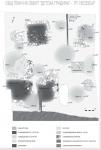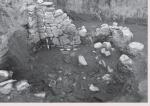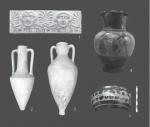Summary (English)
EXPLORATIONS IN MESAMBRIA – MESEMVRIA (Todor Marvakov – tmarvakov@abv.bg) Six pits were explored: pit No. 5 contained material of the 11th century, pit No. 10 contained material of the 12th century, pits Nos. 1, 3, 6 and 8 contained material and coins of the 14th century. Two more pits were explored: pit No. 9 contained Hellenistic pottery and pit No. 7 contained Thracian hand-made pottery of the Early Iron Age. A room dug out into the bedrock and dated to the 4th century BC was discovered. The finds included an amphora of Heraclea Pontica with a stamp that reads Έπί Παυσανία, a red-figure skyphos (Fat Boy Рainter), fragmentary small cups, jugs and dishes, three terracotta sima, each one showing show a semipalmette, a head of a Satyr, a palmette, a head of a Nymph, a semipalmette and a Meander, with traces from paints: yellow on the hairs of the Nymphs and the Satyrs, light red and blue on the Meanders, dark red on the palmettes. The exploration of room No. 1 of the second half of the 5th century BC continued. The finds included a terracotta figurine of Kybele, sherds from amphorae and black-gloss pottery, and terracotta loom weights. Tiles from the roof of the room were also found. Two more rooms with similar material were found to the south. The finds from room No. 3 included two Chian amphorae of the second half of the 5th century BC and sherds from black-gloss pottery. The bottoms of three dolia were discovered in rooms Nos. 1, 2 and 3. The three rooms were basements of houses. Sherds from a black-figure oinochoe showing a Satyr and a Maenad (Leafless Style) and dated to the end of the 6th – beginning of the 5th century BC were found in rooms Nos. 2 and 3. These shreds originated from an earlier demolished structure which was documented under the floor of room No. 3 where a sherd from a Cassel Cup of 530 – 520 BC was found. The structure was related to the beginning of the Greek colonization in c. 510 BC.
- Todor Marvakov - ‘Old Nesebar’ Museum
Director
Team
Research Body
- ‘Old Nesebar’ Museum






![Download [PDF]](/excavation/skins/fasti/images/results/download_sml.png)

